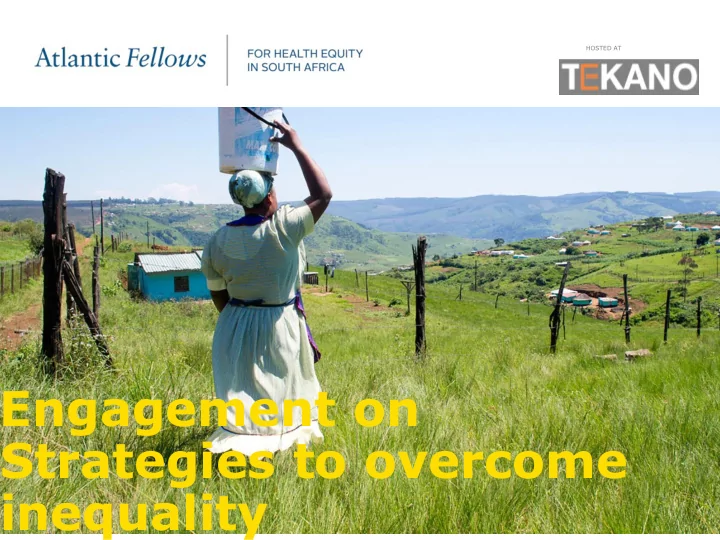

HOSTED AT Engagement on Strategies to overcome inequality
Tekano • a civil society organisation born out of public health activism • supporting leadership development and activism to address the social determinants of health • funded by Atlantic Philanthropies as a legacy project 2
Social determinants “… the circumstances in which people are born, grow up, live, work and age, and the systems put in place to deal with illness.” (WHO Commission on the Social Determinants of Health, 2008) “ These circumstances are shaped by the distribution of money, power and resources at global, national and local levels, which are themselves influenced by policy choices. The social determinants of health are mostly responsible for health inequities - the unfair and avoidable differences in health status seen within and between countries .” (Source: WHO - http://www.who.int/topics/social_determinants/en/)
"(The) toxic combination of bad policies, economics, and politics is, in large measure responsible for the fact that a majority of people in the world do not enjoy the good health that is biologically possible. Social injustice is killing people on a grand scale."
Leading causes of premature mortality in South Africa in 2013: HIV/AIDS (15.5%) TB (12.4%) Lower respiratory infections (8.3%) Diarrhoeal diseases (5.7%) Cerebrovascular disease (4.6%) Hypertensive heart disease (3.3%) Ischaemic heart disease (3.3%) Diabetes mellitus (2.8%) Road injuries (2.6%) Massyn N, Peer N, Padarath A, Barron P, Day C, editors. District Health Barometer 2014/15. Durban: Health Systems Trust; October 2015
Social determinants – diagram Source: Western Cape Burden of Disease Reduction Project (2007)
Example 1: Determinants of child health Proximal – downstream- immediate Co-morbidities Low birth weight Malnutrition Maternal malnutrition; Maternal HIV positive status Infectious disease Behavioural Lack of exclusive breastfeeding Poor hand-washing before preparation of food, after defaecation Socio-cultural - intermediate Women’s decision -making power and access to resources in home and community is reduced Distal – upstream-social determinants Living and working conditions Inadequate drinking water Inadequate sanitation Overcrowding and poor ventilated structures Access to effective, quality health services (incl immunisation, antenatal care) Maternal education Income - poverty Structural Inequity in political power and resource distribution
Example 2: Determinants of NCDs - (hypertension, diabetes, cerebrovascular diseases ) Proximal – downstream - immediate Host Genes; Age Thrifty phenotype hypothesis Co-morbidities Obesity; Increased abdominal girth Hypertension Behavioural Smoking Physical inactivity Diet high in calories and low in grains and fibre Socio-cultural - intermediate Social exclusion and lack of social support Perceived lack of control and inequity Distal - upstream -social determinants Living and working conditions Accelerated urbanisation – where recreational infrastructure lags behind. Local food environment Access to effective, quality health services (incl diagnosis, monitoring, care, rehabilitation) Occupation, Literacy Structural Trade liberalisation facilitates increasing supply of processed and ultra-processed foods (incl ‘fast food’)
Example 3: Determinants of HIV Proximal – downstream - immediate Host Biological vulnerability of women (and especially young women) Co-morbidities STIs People living with HIV (not on ART) – at risk of TB Behavioural Non-use of condoms; Coercive & forced sex – including rape; Alcohol / drug use reduces healthy decision-making; Sharing unsterilized sharp instruments (needles, syringes, blades) Socio-cultural - Patriarchal gender norms; Child marriage; Cultural intermediate beliefs around MMC; HIV-related stigma prevents PLHIV accessing services Distal - upstream -social determinants Living and working Transactional / commercial sex ; Migrant labour conditions systems & the enforced separation of families Vulnerable groups (eg refugees, MSM) – not accessing health services; Public safety – girls and women Structural Sex trafficking; Discriminatory legislation related to PLHIV Unequal access to education, economic opportunities
Social determinants: the “causes of the causes” There is a confluence of social determinants of the main causes of premature mortality • Water and sanitation • Low levels of social • Food environment cohesion • Alcohol • Inadequate health system response They operate at different levels and require different actions: • Global • National • Local
Some questions raised yesterday • What is our working definition of inequality? • Is inequality necessarily a bad thing? To what extent is some inequality productive, in that it drives growth? [Lewis model] • Is climate change an inequity issue? • How do we build resilience in economic models (and health systems)? • Is premature urbanisation a threat or opportunity? Tekano 13
What strategies can we use to address the problems we have identified? Sense of frustration • Data exists but is not used • How do we get the issues of poverty and inequality on the agenda again Tekano 14
Social inequity is already on the agenda
We have learned from our history, social mobilisation got us our freedom….human rights without social mobilisation is not enough
FELLOWSHIP PROGRAMME PARTNERING ACROSS GOVERNMENT, CIVIL SOCIETY AND SOCIAL MOVEMENTS TEKANO 3rd Floor Isivivana Centre 8 Mzala Street Khayelitsha 7784 Cape Town South Africa www.tekano.org.za
Recommend
More recommend